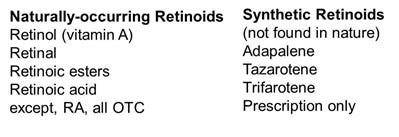The mighty retinoids: the good, the bad, and the ugly
Unlike any of the other cosmetic ingredients we discussed so far, the topic of this article-retinol and its derivatives-is somewhat different. So far, we have reviewed only the cosmetic ingredients that have excellent safety profiles-huge benefits, and very low risks of use (that’s why vitamin C is one of our absolute favorite ingredients). Retinol, on the other hand, is a very effective ingredient that will improve your skin’s appearance, but it does come with a warning label. Let’s dive in, shall we?
Retinol is an umbrella term for several derivatives of vitamin A: retinol, retinaldehyde, retinoic esters, and retinoic acid (all natural molecules). Of the four, it is the retinoic acid (RA) that’s the active compound for skin rejuvenation or acne treatment. Retinol, retinal, and retinoic esters all need to convert to RA to be effective. For that reason, they are less potent than RA, but also gentler on the skin. There are also synthetic retinoids, such as tazatorene and adapalene, which are not available in nature, that are used in high potency creams.
RA gels and creams are available by prescription only, whereas retinol, retinal, and the esters products are all available over the counter. Since retinal needs only one step to convert to RA, it’s more potent and effective than esters or retinol, which need three and two steps, respectively. That can be your guide when choosing which product to use.
Natural vs. Synthetic
Vitamin A (retinol) and its derivatives are all naturally-occurring molecules-we get them from our food in two forms-vitamin A, as well as provitamin A (carotenoids). They are both stored in the liver. The skin cells called keratinocites store and convert majority of vitamin A to retinyl esters, likely because retinoic esters are more stable than other forms of vitamin A.
In addition to the naturally-occuring retinoids, there are synthetic ones as well (those that are not found in nature). They are molecules that, despite being different in structure from vitamin A, have similar effects on skin. The bright minds in pharmaceutical and cosmetic houses are working on ever more synthetic retinoids, so this list is bound to increase.
The Good
We have several retinoid receptors in our skin. In epidermis (the outer layer of the skin), there are three types of RA receptors, and in the dermis (middle layer) there are two. What happens when RA or another retinoid binds to the receptors? The binding causes a cascade of events that leads to expression of genes that control collagen production and cell turnover. One of the effects of RA is the blocking of proteins that degrade collagen. Additionally, RA use leads to new collagen production, so it is doubly-beneficial for collagen in skin. Retinoids diminish acne as well as lower the inflammatory conditions of the skin such as psoriasis or rosacea. The list of benefits goes on and on:
-
They reduce the appearance of wrinkles-retinol is renowned for reduction of wrinkles, by stimulating the production of collagen.
-
They increase skin cell turnover, and by doing so, make the skin look more even-toned, smooth and less pigmented.
-
They improve skin elasticity.
-
They can help unclog pores, which is one of the reasons why they are helpful in treating acne, as well as reducing blackheads and whiteheads.
The Bad
Overuse of retinoids can lead to skin dryness, irritation, photosensitivity, redness and even blistering. For that reason, you may want to start applying every other day, for example, to see if you can tolerate it. Then ramp up if your skin allows it. Retinol and its derivatives are sensitive to light (and can make your skin sensitive to light, too), so it’s advisable to use it only at night. During the day, you should use sunscreen to further protect the skin.
Retinoids are used orally as well as topically for treatment of acne. They are very effective, especially in combination with benzoyl peroxide or antibiotics (here of course, we have to remind our readers of the wonderful vitamin B3, a.k.a. niacinamide. It is comparable to antibiotics and RA in clearing acne. We are of the opinion that antibiotics should be used when needed, but not overused-if you have acne, give vitamin B3 a try first. It might be just as effective without any adverse effects).
The Ugly
Retinol can cause severe birth defects when used orally during pregnancy. It’s less clear how dangerous topical use is for the unborn baby, but despite that, err of the side of caution: if pregnant, planning for pregnancy, or nursing, do not use retinol products. It’s not worth the risk. We cannot emphasize this enough.
Does beta carotene from carrots have the same benefits/risks as retinoids? Don’t carrots have vitamin A? In a word, no. Beta carotene is related in structure to retinoids (it is so called pro-vitamin A), but it doesn’t bind to retinoid receptors. No effects on collagen or acne, but fortunately, none of the risks either. So, eat your carrots, ladies and gentlemen-they are unequivocally good for you, but for other reasons.
Retinoids are a potent weapon in our arsenal to fight the effects of time on our faces, as well as many other skin conditions unrelated to ageing. They are very effective, but can be too harsh for sensitive skin, and downright dangerous when used in pregnancy. If interested in using them, you should be wise to all their effects, both positive and negative.
Disclaimer: None of this is medical advice.
Reference:
A Clinician’s Guide to Retinoids, Journal of Cutaneous Medicine and Surgery, 2022, 26 (1), 71-78.


